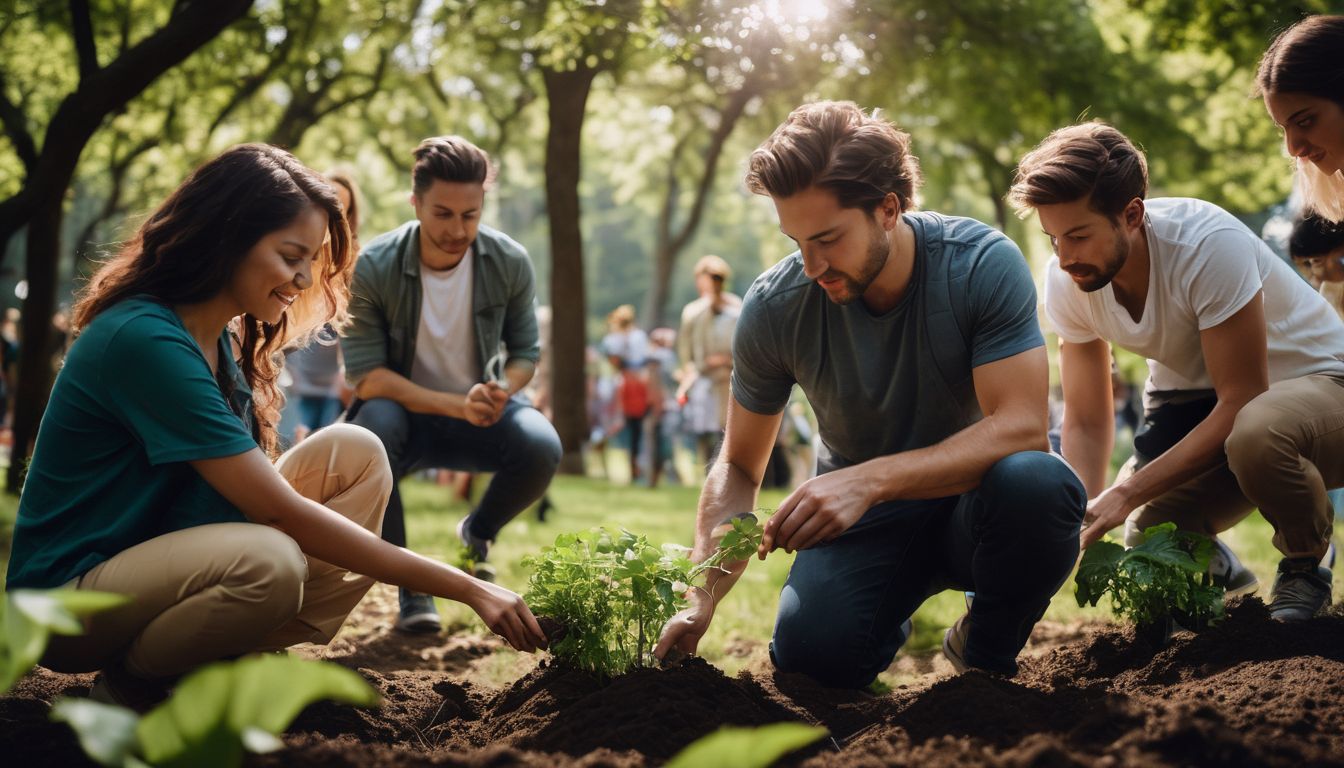FEATURED
Sustainable Landscaping

Struggling to maintain your garden without overusing resources? You’re not alone! Did you know, sustainable landscaping can significantly reduce water consumption and maintenance labor while enhancing biodiversity? This blog will guide you through steps to create a green, attractive landscape that respects our natural resources.
Let’s dive into the world of sustainability within your own backyard!
What is Sustainable Landscaping?

Sustainable landscaping is a method that aims to harmonize your yard or garden with the local climate and natural ecosystem. It requires thoughtful planning, design, and maintenance practices that conserve resources while creating an outdoor space you can enjoy.
Sustainable landscape design involves using low-impact materials and builder’s methods to reduce harmful effects on the environment.
This eco-friendly approach prioritizes soil health, using practices which enrich the ground naturally over time and nurture plant growth. It also seeks to minimize waste generation by reusing materials whenever possible or composting organic waste back into the earth leading to sustainable gardening.
Water conservation plays a key role in sustainable landscaping. Efficient irrigation systems are designed for water-wise usage, often incorporating rainwater harvesting techniques so as not to deplete valuable groundwater resources unnecessarily.
Native plants are typically chosen for these landscapes because they require less water than non-native species and are more resistant to pest outbreaks.
Furthermore, there’s a conscious effort in sustainable landscaped spaces towards reducing energy consumption through the use of manual tools where feasible instead of gas-powered ones curtailing fuel emissions significantly.
The unique beauty of sustainably landscaped yards lies not only in their aesthetic appeal but also in how they contribute positively towards maintaining our planet’s ecological balance.
Benefits of Sustainable Landscaping

Sustainable landscaping offers numerous benefits such as conserving water, reducing waste, preserving natural resources, enhancing biodiversity, and creating a healthier environment.
Conservation of water
Reducing our water consumption plays a significant role in sustainable landscaping. By designing landscapes with climate-appropriate plants and efficient irrigation systems, we can drastically cut down on the amount of water needed to maintain lush, healthy yards.
Native plants are often more resistant to local pests and diseases, requiring less treatment and watering while still providing beauty and function to your landscape.
Implementing a home irrigation system is another effective strategy for conserving water in sustainable landscaping. These systems allow homeowners to target specific areas that need watering, eliminating wasteful over-watering or indiscriminate sprinkler use which can lead to unwanted runoff.
Efficiently utilizing rainwater through harvesting methods also helps reduce reliance on municipal or well water sources, contributing significantly towards environmental sustainability within our communities.
Reduction of waste
Implementing sustainable landscaping involves minimizing waste to protect the environment. Practices like composting turn organic waste such as leaves, grass clippings, and kitchen scraps into nutrient-rich soil amendments for your garden.
This eco-friendly practice reduces the amount of waste sent to landfills, and simultaneously enhances soil fertility for plant growth in a natural way. Utilizing fallen leaves as mulch is another excellent method for reducing yard waste while keeping your plants hydrated and suppressing weed growth.
Reusing old or repurposed materials in landscape design also helps cut down on material consumption, serving dual purposes: creating unique aesthetics for your backyard and preserving resources effectively.
Preservation of natural resources
Sustainable landscaping practices play a crucial role in the preservation of natural resources. By implementing eco-friendly techniques, homeowners can reduce the consumption of water, energy, and other valuable resources.
Sustainable gardening promotes soil health and fertility, minimizing the need for synthetic fertilizers and pesticides. Additionally, native plants and wildlife are integral to sustainable landscaping, as they contribute to biodiversity conservation.
By focusing on responsible resource management, homeowners can take part in creating a healthier environment for both humans and nature.
Enhancement of biodiversity
Sustainable landscaping plays a crucial role in enhancing biodiversity. By incorporating native plants and creating habitats for wildlife, homeowners can promote a thriving ecosystem right in their own backyard.
This not only attracts beneficial insects, birds, and other pollinators but also helps to maintain the balance of nature. Sustainable landscaping practices preserve and protect the local flora and fauna, ensuring that ecosystems continue to thrive for future generations.
Creation of a healthier environment
Sustainable landscaping plays a crucial role in creating a healthier environment for you and your community. By implementing eco-friendly practices, such as conserving water and reducing chemical use, sustainable landscaping promotes the overall well-being of both humans and nature.
Not only does it help to preserve natural resources, but it also improves air and water quality, ensuring a cleaner and safer environment for everyone. Additionally, sustainable landscaping fosters biodiversity by creating habitats for native plants and wildlife, contributing to the overall balance of local ecosystems.
By adopting these practices, you can make a positive impact on your surroundings while enjoying the benefits of a thriving and vibrant landscape.
Designing a Sustainable Landscape
Design a sustainable landscape by implementing erosion control measures, incorporating native plants, using permeable hardscapes, and practicing xeriscaping techniques.
Erosion control
Sustainable landscaping includes effective erosion control measures to prevent soil erosion and maintain the integrity of your landscape. By using techniques such as terracing, retaining walls, and groundcover plants, you can stabilize slopes and minimize the risk of erosion.
Applying mulch on exposed soil also helps to retain moisture and protect against wind and water erosion. These practices are crucial for keeping your landscape healthy, preserving the fertility of the soil, and preventing runoff that can lead to pollution in nearby bodies of water.
Incorporating erosion control into your sustainable landscaping plan ensures a long-lasting and environmentally-friendly outdoor space.
Use of native plants
Native plants are an essential component of sustainable landscaping. These plants have adapted to the local climate and soil conditions, making them more resilient and less dependent on excessive water or fertilizer.
By using native plants in your landscape, you can reduce the need for additional watering and maintenance while providing habitat for local wildlife. Native plants also help preserve biodiversity by supporting pollinators such as bees and butterflies.
Incorporating these plants into your garden not only adds beauty but also contributes to a healthier and more sustainable environment.
Implementation of permeable hardscapes
Implementing permeable hardscapes is a key aspect of sustainable landscaping. Permeable hardscapes are surfaces that allow water to penetrate through, preventing runoff and promoting groundwater infiltration.
This helps to prevent flooding, reduce stormwater pollution, and replenish local water sources. By using materials such as pervious concrete or gravel instead of traditional impervious surfaces like asphalt or concrete, homeowners can create attractive pathways, driveways, and patios that also contribute to the environmental health of their property.
With permeable hardscapes in place, rainwater can be absorbed by the ground rather than being wasted or contributing to erosion. So not only do these features add beauty to your landscape but they also provide practical benefits for water conservation and sustainability efforts overall.
Water Management in Sustainable Landscaping
Implementing rainwater harvesting, efficient irrigation systems, and water-wise plant selection are essential components of sustainable landscaping practices.
Efficient irrigation systems
Efficient irrigation systems are an important component of sustainable landscaping. They help to minimize water waste and promote responsible water usage. Here are some key points to consider:
- Drip irrigation: This system delivers water directly to the root zone of plants, reducing evaporation and ensuring that water is used efficiently.
- Smart irrigation controllers: These devices use weather data and sensors to automatically adjust watering schedules based on current conditions. This helps to prevent overwatering and saves water in the process.
- Soil moisture sensors: These sensors measure soil moisture levels, allowing homeowners to determine when it’s necessary to irrigate their landscape. By only watering when needed, water usage can be significantly reduced.
- Rainwater harvesting: Collecting rainwater from roofs and using it for irrigation is a sustainable practice that reduces dependence on municipal water supplies.
- Mulching: Adding mulch around plants helps to retain moisture in the soil, reducing the need for frequent watering.
Water-wise plant selection
To ensure a sustainable landscape, it is crucial to select plants that are efficient in their water usage. By choosing water-wise plants, homeowners can reduce their water consumption and create a more environmentally friendly garden. Here are some key points to consider when selecting water-wise plants:
- Native Plants: Opt for native plant species that are well adapted to the local climate and require less water compared to non-native varieties. Native plants have evolved to thrive in the region’s specific conditions, making them more drought-tolerant and resilient.
- Drought-Tolerant Varieties: Choose plants that are naturally more resistant to dry conditions. These plants have adapted mechanisms such as deep root systems or fleshy leaves to store water, allowing them to survive with minimal watering.
- Xeriscaping: Incorporate xeriscaping principles into your design, which involves using a mix of grasses, shrubs, and groundcovers that are well-suited for arid regions. Xeriscaping reduces the need for irrigation by relying on low-water-use plants and strategic placement.
- Grouping Plants by Water Needs: Arrange your garden so that plants with similar water requirements are grouped together. This allows for efficient irrigation practices since you can tailor the watering schedule and amount based on specific zones within your landscape.
- Mulching: Apply a layer of organic mulch around plants and in garden beds. Mulch helps retain soil moisture by reducing evaporation, minimizing weed growth, and regulating temperature fluctuations.
Reducing Chemical Use in Landscaping
Homeowners can reduce the use of chemicals in landscaping by avoiding synthetic pesticides and fertilizers, implementing organic pest control methods, and composting or using natural fertilizers.
Avoiding synthetic pesticides and fertilizers
Synthetic pesticides and fertilizers should be avoided in sustainable landscaping. They can have harmful effects on the environment and disrupt the balance of ecosystems. Instead, consider these alternatives:
- Use organic pest control methods: Employ natural methods like companion planting, beneficial insects, and physical barriers to deter pests without the use of harmful chemicals.
- Implement composting: Composting kitchen scraps and yard waste provides nutrient-rich organic fertilizer for your plants, reducing the need for synthetic alternatives.
- Choose natural fertilizers: Opt for organic fertilizers such as compost tea, bone meal, and fish emulsion. These provide nutrients to plants while minimizing negative impacts on soil health.
Implementing organic pest control methods
Implementing organic pest control methods is an important aspect of sustainable landscaping. Here are some effective and eco-friendly ways to manage pests in your landscape:
- Attract beneficial insects: Encourage the presence of natural predators like ladybugs, lacewings, and praying mantises by planting flowering plants and providing shelter for them.
- Use companion planting: Certain plants, when grown together, can deter pests. For example, marigolds can repel aphids and nematodes when planted near vegetables.
- Practice crop rotation: Rotate your crops each year to disrupt pest life cycles and minimize the buildup of pests in the soil.
- Handpick pests: If you spot small numbers of pests on your plants, manually remove them. This can be done by hand or using a gentle spray of water.
- Apply homemade sprays: Create natural pest control sprays using ingredients like garlic, neem oil, or soap. These can help deter pests without harming beneficial insects.
- Use insect traps: Set up traps to catch specific pests that may be causing damage to your plants. Sticky traps or pheromone-based traps can be effective options.
Composting and using natural fertilizers
Composting and using natural fertilizers are effective practices in sustainable landscaping that homeowners can implement. These methods not only reduce waste but also provide essential nutrients to support healthy plant growth. By composting organic materials such as yard trimmings, food scraps, and grass clippings, homeowners can create nutrient-rich soil amendments that improve the overall health of their landscape. In addition, using natural fertilizers like compost tea or manure-based products can help maintain a balanced ecosystem and limit the use of synthetic chemicals. Incorporating these practices into your sustainable landscaping routine promotes environmental sustainability and contributes to the vitality of your garden.
Minimizing Fuel Emissions in Landscaping
To reduce fuel emissions in landscaping, use electric or manual tools, mow and trim less frequently, and explore alternative transportation methods. Find out more about sustainable practices in landscaping by reading the full article.
Using electric or manual tools
Using electric or manual tools is a sustainable practice in landscaping that helps reduce fuel emissions and promote a healthier environment. By opting for these tools, homeowners can contribute to the conservation of natural resources and minimize air pollution. Here are some benefits of using electric or manual tools:
- Reduced carbon emissions: Electric tools produce zero emissions, while manual tools don’t require any fuel at all. This means less air pollution and a smaller carbon footprint.
- Noise reduction: Unlike gasoline-powered tools, electric or manual ones operate quietly, creating a more peaceful environment for both homeowners and their neighbors.
- Cost-effective: Electric tools may have a higher initial cost, but they are generally more energy-efficient and require less maintenance compared to their gasoline counterparts. Manual tools, on the other hand, have no ongoing costs.
- Easy maintenance: Electric tools do not require oil changes or spark plug replacements like gasoline-powered ones. Manual tools need minimal maintenance as well.
- Safer operation: Electric or manual tools tend to have safer designs than their gasoline-powered equivalents. There is no need to handle flammable fuels or worry about accidental leaks.
Reducing mowing and trimming frequency
To promote sustainable landscaping practices, homeowners can reduce mowing and trimming frequency. This not only saves time and effort but also has several environmental benefits. By reducing mowing and trimming frequency, homeowners can:
- Conserve fuel and minimize air pollution from lawn mowers and trimmers.
- Preserve native plant species and encourage biodiversity by allowing flowers to bloom and seeds to disperse.
- Provide habitat for beneficial insects like bees and butterflies.
- Limit water consumption as longer grass provides shade to the soil, reducing evaporation.
- Reduce the need for synthetic fertilizers as longer grass naturally stays greener.
Opting for alternative transportation methods
- Use electric or manual tools for landscaping tasks to reduce fuel emissions.
- Consider walking, biking, or using public transportation instead of driving to minimize environmental impact.
- Utilize equipment sharing or carpooling with neighbors or community members for transporting larger landscaping materials.
- Explore the use of eco-friendly and electric-powered vehicles for hauling heavy loads or equipment.
- Incorporate sustainable transportation practices into your overall landscaping plan to further reduce carbon emissions.
Sustainable Landscaping Maintenance and Care Practices
Maintaining and caring for a sustainable landscape is crucial to ensure its long-term success. Regular maintenance practices help to preserve the health and beauty of your eco-friendly garden.
One important aspect of sustainable landscaping maintenance is proper lawn care techniques. By mowing at the correct height, aerating the soil, and fertilizing with natural products, you can promote healthy grass growth while minimizing water and chemical use.
Additionally, transitioning to eco-friendly lawns that require less maintenance and resources is an effective way to support sustainability efforts. Another key practice in maintaining a sustainable landscape is limiting water usage.
Using efficient irrigation systems and choosing water-wise plant varieties can significantly reduce water consumption without compromising the beauty of your garden. By implementing these sustainable maintenance practices, you can create a thriving outdoor space that benefits both nature and your community.
Sustainable Lawn Care Practices
Implement proper lawn maintenance techniques, transition to eco-friendly lawns, and limit water and chemical use for a sustainable approach to lawn care.
Proper lawn maintenance techniques
Maintaining your lawn properly is an important aspect of sustainable landscaping. Here are some techniques to keep in mind:
- Regular mowing: Keep your grass at a height of around 3 inches to promote healthy growth and discourage weeds.
- Mulching: Use grass clippings as natural mulch, which helps retain moisture in the soil and adds nutrients back into it.
- Aerating: Loosen compacted soil by aerating it, allowing water, air, and nutrients to reach the roots more easily.
- Overseeding: Fill in bare patches on your lawn by overseeding with grass seed that is suitable for your region’s climate.
- Watering wisely: Water deeply and infrequently rather than shallowly and frequently to encourage deep root growth.
- Avoid overfertilizing: Use organic fertilizers sparingly and follow the recommended application rates to prevent runoff into water sources.
- Weed control: Pull weeds manually or try natural weed control methods rather than relying on chemical herbicides.
- Pest management: Monitor your lawn for pests such as grubs and use organic pest control methods when necessary.
Transitioning to eco-friendly lawns
Transitioning to eco-friendly lawns is a great way to reduce your environmental footprint and create a healthier outdoor space for you and your family. Here are some key steps to help you make the transition:
- Replace traditional grass with native or drought – resistant grass species that require less water and maintenance.
- Consider incorporating alternative ground covers like clover or moss, which are more resilient to drought and require less mowing.
- Implement organic lawn care practices, such as using compost instead of synthetic fertilizers and natural pest control methods.
- Reduce the size of your lawn by adding more landscape beds or creating functional spaces like vegetable gardens or play areas.
- Install rain barrels or cisterns to collect rainwater for irrigation, reducing the need for tap water usage.
- Use mulch around plantings to retain moisture in the soil, suppress weeds, and provide nutrients as it breaks down over time.
- Maintain proper lawn height by mowing at a higher setting, which helps promote stronger root growth and shade out weeds.
- Limit the use of pesticides on your lawn by practicing integrated pest management techniques, such as regular monitoring and targeted treatments.
Limiting water and chemical use
To achieve a sustainable landscape, homeowners can take steps to limit water and chemical use. Here are some effective practices to consider:
- Choose native plants: Native plants are adapted to the local environment and require less water and maintenance compared to non-native species.
- Install a rainwater harvesting system: Collecting rainwater allows you to utilize natural resources instead of relying solely on municipal water supplies for irrigation.
- Use efficient irrigation systems: Upgrade to smart irrigation controllers that adjust watering schedules based on weather conditions, soil moisture levels, and plant needs.
- Incorporate water-wise plant selection: Opt for drought-tolerant plants that have low water requirements, reducing the need for constant watering.
- Implement proper mulching techniques: Mulching helps retain soil moisture by reducing evaporation, minimizing the need for frequent watering.
- Practice proper lawn maintenance: Adjust your lawn mower height to a higher setting, which encourages deeper root growth and reduces the need for frequent watering.
- Limit fertilizer and pesticide usage: Instead of relying on synthetic products, consider organic alternatives or implement integrated pest management strategies to minimize chemical use.
- Implement composting: Composting kitchen scraps and yard waste not only reduces organic waste but also enriches the soil naturally, reducing the need for chemical fertilizers.
- Regularly monitor and adjust watering schedules: Monitor your landscape’s water needs throughout different seasons and modify irrigation schedules accordingly to avoid unnecessary water wastage.
- Consider alternative landscaping options: Explore xeriscaping or other climate-appropriate landscaping techniques that minimize water usage while maintaining an aesthetically pleasing outdoor space.
FAQs
1. What is sustainable landscaping?
Sustainable landscaping involves using environmentally friendly practices to create and maintain outdoor spaces that are both beautiful and eco-friendly.
2. How can I make my landscape more sustainable?
You can make your landscape more sustainable by conserving water, using native plants, practicing proper soil management, minimizing chemical use, and promoting biodiversity.
3. Why is sustainable landscaping important?
Sustainable landscaping is important because it helps conserve natural resources, reduces pollution, supports local wildlife habitats, and contributes to a healthier environment for future generations.
4. Can I still have a visually appealing landscape with sustainable practices?
Yes! Sustainable landscapes can be just as visually appealing as traditional ones. By choosing the right plants, incorporating different textures and colors, and utilizing smart design principles, you can create a stunning landscape that also benefits the environment.
5. Is sustainable landscaping expensive?
While there may be initial costs associated with implementing sustainable practices in your landscape (such as installing irrigation systems or purchasing drought-tolerant plants), over time it can actually save you money through reduced maintenance needs and lower water bills.

